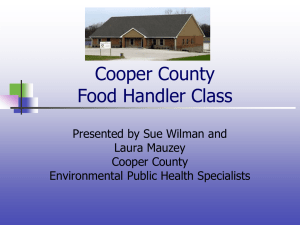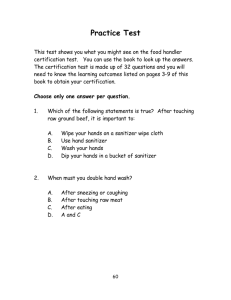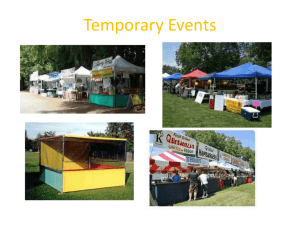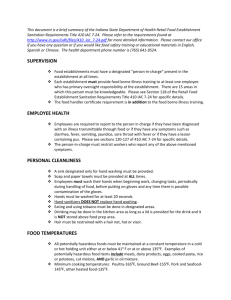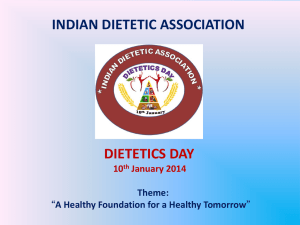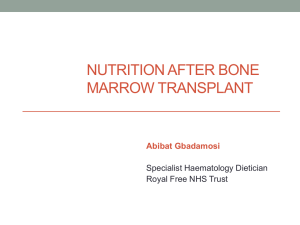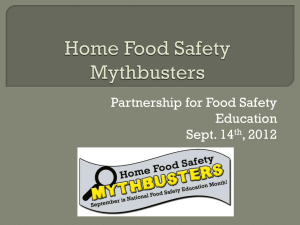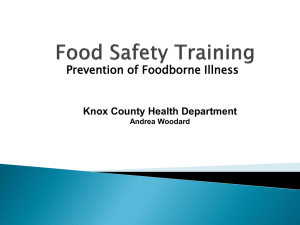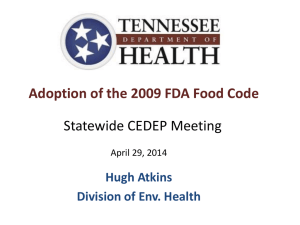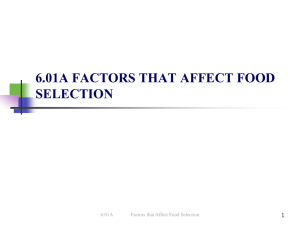Iowa Department of Inspections and Appeals
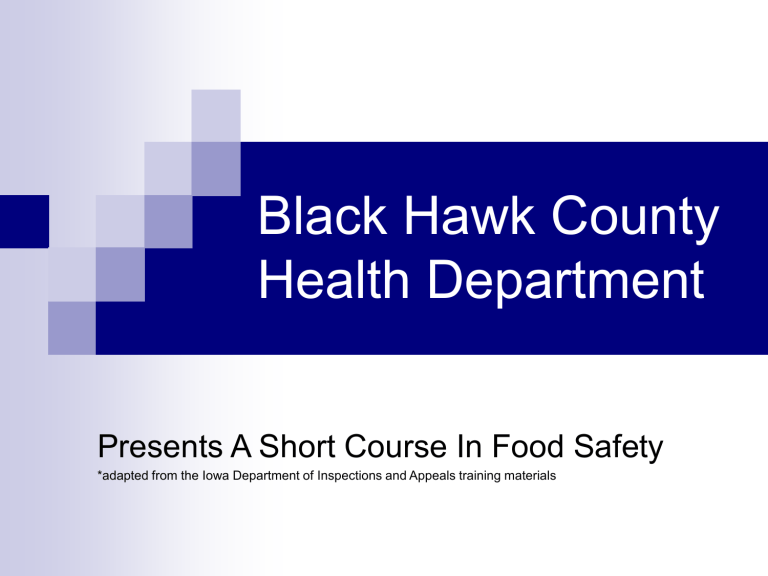
Black Hawk County
Health Department
Presents A Short Course In Food Safety
*adapted from the Iowa Department of Inspections and Appeals training materials
Food Safety Begins With You !
Follow these tips!!
Keep hair restrained.
Do not eat drink or smoke while at work.
Be healthy.
Wear clean, neat clothing.
Do not wear jewelry.
Have clean, washed hands and fingernails.
Highly susceptible populations-
Includes:
Elderly
Immune compromised-
Organ recipients
Diabetics
HIV positive
Infants and the young
Women who are pregnant
Seniors are considered to be a highly susceptible population.
WASH your HANDS!!
Use soap and warm running water ( minimum of 100 degrees )
Rub hands together for 20 seconds, up to elbows.
Wash backs of hands, wrists, between fingers, and under fingernails.
Rinse hands under running water.
Turn off running water with a paper towel, not bare hands.
Dry hands with paper towels or air dryer. Avoid common use cloth towels
WASH your HANDS!!!
Before
Handling, preparing or serving foods, and handling clean dishes or utensils.
After
Using the restroom, smoking, eating or drinking, handling raw meats, touching unclean equipment, working areas, aprons, sponges or cloths, taking out the garbage or touching your face or hair.
NO BARE HAND CONTACT
Bare hand contact with ready-to-eat (RTE) food is prohibited. When handling RTE foods, food service workers shall use:
• Deli Tissues
• Spatulas
• Tongs
• Forks
• Dispensing Equipment
• Single-Use Gloves
NO BARE HAND CONTACT with ready-to-eat foods
Single-Use Glove Guidelines
Glove usage does not replace the need for proper hand washing practices.
Wash hands before putting on gloves.
Put gloves on only when you are ready to handle RTE food.
Use gloves for only one task, then discard .
If an interruption occurs during food preparation, remove gloves.
Use clean gloves immediately upon removal.
Single-use gloves should not be used around heat or hot fats.
Gloves are susceptible to contamination, so discard when soiled or damaged.
Fabric or re-usable gloves may not be used with RTE food.
Avoid single use gloves made of natural rubber latex. (Due to sensitivities to latex products.)
Demonstration of Knowledge
Person in Charge (PIC)
The PIC is responsible for ensuring that staff is knowledgeable in FBI prevention, food safety principles, HACCP, etc.
This shall be demonstrated by code compliance, answering questions correctly, or having completed an approved food safety certification course.
The Big “5”
Norovirus
Salmonella typhi
Hepatitis A
E.coli 0157:H7
Shigella
Disease Reporting
The PIC is responsible to ensure that employees with the Big “5” are not being allowed to work.
An employee with one of the big “5” must be reported to the health department by the PIC.
The affected employee shall be EXCLUDED or
RESTRICTED from food handling, etc. A Health
Practitioner release may be required for the exclusion/restriction lifted.
Avoid Cross Contamination
Store raw meats below pre-cooked or other ready to eat foods.
Wash your hands.
Wash and sanitize utensils and cutting boards.
Use separate cutting boards and preparation areas for raw meats and vegetables.
Use different utensils for different food items.
Use separate sanitizer buckets for different food products and food contact surfaces.
Potentially Hazardous Foods (PHF)-
Also known as-Time/Temperature Control for Food Safety (TCS)
PHF/TCS means any food or food ingredient, natural or synthetic, capable of supporting rapid growth of microorganisms.
A food is potentially hazardous if it is:
A. Of animal origin, such as meat, milk, fish, shellfish, edible crustacean, or poultry.
B. Of plant origin that has been heat treated (for example: cooked rice, beans, potatoes, pasta)
C. Raw seed sprouts.
New to Code!
Tomatoes have been added to the list of
PHF/TCS.
Producers have achieved lower acidity levels due to changes in the consumers’ needs.
Keep hot foods
HOT
and cold foods
COLD
!
The temperature danger zone is between 41 ºF and 135ºF.
This temperature range is ideal for organism growth.
MINIMUM TEMPERATURE GUIDELINES
FOR COOKING RAW FOODS
Poultry (Solid & Ground) 165 °F/74°C for 15 seconds.
Pork, Game 145 °F/68°C for 15 seconds.
Veal, Lamb, other Red Meats 155 °F/68°C for 15 seconds.
Fish 145 °F/63°C for 15 seconds.
Injected Meats 155 °F/68°C for 15 seconds.
Roast Beef 130 °F/54°C for 121 minutes
Shell Eggs (for immediate service) 145 °F/63°C for 15 seconds.
Shell Eggs (not for immediate service) 155 °F/68°C for 15 seconds.
Stuffed Foods (Meat, Poultry, Seafood, Pasta) 165 °F/74°C for 15 seconds.
Ground or Flaked Fish and Meats 155 °F/68°C for 15 seconds.
Use that thermometer !
1.
2.
3.
Clean and sanitize your thermometer after each use.
Insert probe into the thickest part of the food.
Read temperature when needle or digital read-out stabilizes.
NOT HOT ENOUGH? SEND IT BACK!!
New to Code!
A small diameter probe (1.5mm) is required to obtain accurate temperatures on thin masses. Foods such as meat, fish or chicken patties are considered thin.
Calibrate that thermometer!!
1.
2.
3.
4.
5.
Insert thermometer probe into a cup of water with crushed ice.
Wait 3 minutes.
Thermometer should read
32 °F.
If it does not, turn the adjustment nut on the back of the reading dial until the dial reads 32 °F. (Keep the probe in the ice while adjusting.)
Wait 3 more minutes to verify correct adjustment.
Hot & Cold Holding
Hot foods shall be maintained at an internal temperature of 135 °F or higher.
Cold foods shall be maintained at an internal temperature
41 °F or less.
Proper holding temperature must be maintained during transportation (catering).
Do not mix new product with leftover product.
To maintain proper hot holding food temperatures in a water-based steam table, the water shall be held at least 30 °F higher than the holding temperature of the food. (example: water temperature of
165 °F will hold food at 135°F) Routinely check food temperatures to ensure safety.
Improper Cooling Causes 63% of
FBI’s!
Approved time frames for cooling-
1.
Cool foods from 135 °F to 70°F in 2 hours; and within a total of 6 hours from
135 °F to 41°F or less.
2.
Cool foods from 135 ºF to 41°F within 4 hours.
Approved Methods
Shallow pans – 2-3 inches deep.
Leave pan partially uncovered during cooling
Do not stack hot pans
Provide adequate air circulation
Agitate is possible
Use containers that facilitate heat transfer
Metal pans transfer heat best
Methods continue….
Ice Bath – must use ice and water
Utilize sink or larger container for ice bath.
Agitate/stir often.
Immerse product pan to depth of product.
Leave partly or totally uncovered.
Small or Thinner Portions
Divide product into smaller quantities/portions.
Add Ice as an ingredient
Withhold water during cooking, then add ice at end.
Excellent method for watery soups.
Purchase a blast chiller or add more walk-in space
Other Effective Methods
Reheating
Food must be reheated in 2 hours or less to an internal temperature of 165 °F for 15 seconds.
When using a microwave, reheat to 165 °F and hold for 2 minutes.
Commercially processed, packaged ready to eat foods may be reheated to 135 °F.
Measure the internal temperatures with a bi-metallic or thermocouple stem thermometer.
After food reaches 165 °F for 15 seconds, it may be held at
135 °F or above.
Range top is ideal for reheating. You may also use steam cooker, conventional, convection, or microwave oven.
Other equipment may be used if capable of reheating to
165 °F in 2 hours. Crock pots and slow cookers should not be used for reheating.
Do not mix new product with leftover items.
Never reheat previously prepared foods more than once.
Dishwashing 101
Manual warewashing-
•Three compartment sink
•Wash
•Rinse
•Sanitize-
•chemical or heat
•Air dry
Note: This sink is missing a drain board.
Dishwashing 101
Mechanical warewashing-
Maybe either chemical sanitizer or heat sanitizing
